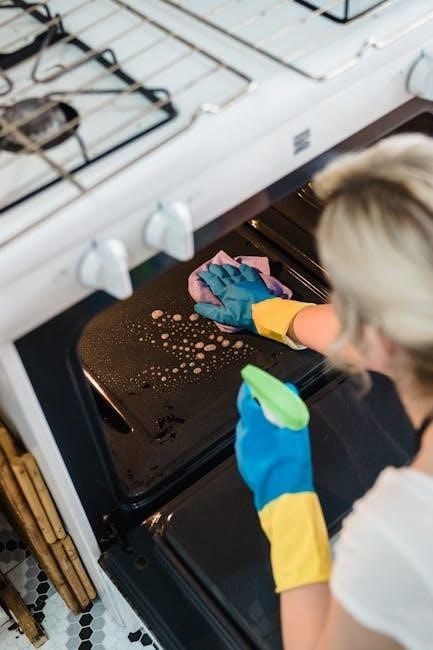GE Self-Cleaning Oven Manual: A Comprehensive Guide
Welcome to your comprehensive guide to mastering your GE self-cleaning oven! This manual provides detailed instructions, safety precautions, and helpful tips to ensure efficient and safe oven operation․ Learn how to maximize your oven’s cleaning capabilities and maintain its optimal performance․

Understanding the Self-Cleaning Function
The self-cleaning function on your GE oven is designed to simplify oven maintenance by using high temperatures to burn away food residue․ This process transforms spills and splatters into a light ash that can be easily wiped away after the cycle is complete․ The self-clean cycle eliminates the need for harsh chemicals and manual scrubbing, making oven cleaning more convenient and less time-consuming․
During the self-clean cycle, the oven heats to extremely high temperatures, typically around 800-900°F (427-482°C)․ This intense heat incinerates food particles, grease, and other debris that accumulate on the oven’s interior surfaces․ The duration of the self-clean cycle can vary, often ranging from 3 to 5 hours, depending on the oven model and the level of cleaning required․ Some models offer options for shorter or longer cycles to accommodate different cleaning needs․
It’s important to understand that the self-clean cycle involves significant heat, which can generate odors and potentially affect air quality․ Therefore, proper ventilation is crucial during the self-cleaning process․ Opening windows or using a kitchen exhaust fan can help to dissipate any fumes or odors produced during the cycle․ It’s also essential to remove oven racks and any other items from the oven before initiating the self-clean cycle, as these items may become discolored or damaged by the high heat․
Safety Instructions Before Using Self-Clean
Prioritizing safety is paramount before initiating the self-clean cycle on your GE oven․ Due to the high temperatures involved, it is essential to adhere to specific safety guidelines to prevent potential hazards․ First and foremost, ensure that the kitchen is well-ventilated by opening windows or activating the exhaust fan․ This helps to minimize the accumulation of fumes and odors that may be released during the cleaning process․
Before starting the self-clean cycle, meticulously remove all oven racks, baking stones, cookware, and any other items from the oven interior․ These objects can warp, discolor, or sustain damage under the extreme heat․ It’s also crucial to wipe up any excessive spills or food debris from the oven floor to reduce the amount of smoke and ash produced during the cycle․
During the self-clean cycle, the oven door will automatically lock to prevent accidental opening․ Avoid attempting to force the door open while the cycle is in progress or immediately afterward, as the oven remains extremely hot․ Allow the oven to cool completely before unlocking the door and removing any residual ash with a damp cloth․ Keep children and pets away from the oven during the self-clean cycle to prevent burns or other injuries․ If you have birds, remove them from the area, because the fumes can be harmful to them․
Preparing the Oven for Self-Cleaning
Before initiating the self-cleaning cycle on your GE oven, proper preparation is essential for optimal results and safety․ Start by ensuring the oven is completely cool to prevent accidental burns․ Carefully remove all oven racks, cookware, baking stones, and any other items from the oven’s interior․ These items can be damaged or discolored by the high temperatures reached during the self-cleaning process․ Pay special attention to removing any aluminum foil, as it can melt and fuse to the oven surface․
Next, manually remove any large food debris or spills from the oven floor and walls․ Use a scraper or spatula to dislodge baked-on residue, followed by wiping the interior with a damp cloth․ This step reduces the amount of smoke and ash produced during the cycle, improving air quality and preventing potential flare-ups․ For heavy grease buildup, consider using a non-abrasive oven cleaner specifically designed for self-cleaning ovens, following the manufacturer’s instructions carefully․
Finally, ensure the oven vent is clear of obstructions to allow proper air circulation during the self-cleaning cycle․ A blocked vent can lead to uneven cleaning and potential damage to the oven’s components․ By taking these preparatory steps, you can ensure a safe, efficient, and thorough self-cleaning process for your GE oven․
Step-by-Step Guide to Initiating the Self-Clean Cycle
Now that your GE oven is prepared, you’re ready to initiate the self-clean cycle․ First, locate the control panel on your oven․ Press the “Self Clean” button; some models might label it “Clean․” The oven display will likely show default cleaning time, usually around 4 hours and 20 minutes․ You can adjust the cleaning time based on how dirty the oven is․ Use the number pads to enter your desired cleaning duration; shorter times for light cleaning and longer for heavy buildup․
Next, confirm the oven door is fully closed․ The oven door will automatically lock for safety․ The display will show “Door Locked” or a similar message․ Do not attempt to open the door once the cycle has started․ The high temperatures inside pose a burn risk․ Some models may allow you to delay the start of the self-clean cycle․ Press the “Delay Start” button, enter the desired start time, and press “Self Clean” to confirm․
Once the cycle begins, the oven will heat to a high temperature to burn away food residue․ It’s normal to notice some smoke or odor during this process․ Ensure adequate kitchen ventilation by opening a window or using a range hood․ When the cleaning cycle is complete, the oven will automatically shut off and the door will remain locked until it cools down․ Once the oven has cooled sufficiently, the door will unlock, signaling the process is complete․
Cleaning the Oven Interior Manually
Even with a self-cleaning oven, occasional manual cleaning might be necessary for spills or stubborn stains․ Always ensure the oven is cool and the power is off before you begin․ Start by removing the oven racks and any accessories․ These can be washed separately with warm, soapy water․ For the oven interior, prepare a solution of warm water and a mild dish soap․ Avoid harsh chemicals or abrasive cleaners, as they can damage the oven’s surface․

Using a soft cloth or sponge, gently scrub the interior surfaces of the oven, paying attention to areas with baked-on food or grease․ For stubborn stains, create a paste of baking soda and water․ Apply the paste to the affected areas and let it sit for about 15-20 minutes before scrubbing․ Use a non-abrasive scrubbing pad for extra cleaning power, but avoid excessive force․
Once you’ve scrubbed the oven interior, rinse thoroughly with clean water to remove any soap or baking soda residue․ Use a clean, damp cloth to wipe down all surfaces․ Ensure the oven is completely dry before replacing the racks and accessories․ For the oven door, use a glass cleaner to remove streaks and smudges․ Regular manual cleaning, even with a self-cleaning oven, will help maintain its cleanliness and extend its lifespan․
Dealing with Common Self-Cleaning Issues
Even with proper preparation, you might encounter issues during or after the self-cleaning cycle․ One common problem is excessive smoke or burning smells․ This usually indicates that there’s still a significant amount of food debris in the oven․ If this occurs, immediately stop the cycle, allow the oven to cool, and manually clean the excess debris before restarting․
Another issue is the oven door failing to unlock after the cycle․ This could be due to a malfunctioning door lock mechanism or the oven not cooling down sufficiently․ Ensure the oven has completely cooled before attempting to open the door․ If it remains locked, consult your oven’s manual or contact a qualified technician․
Sometimes, the self-cleaning cycle might not completely remove all stains or residue․ In such cases, manual cleaning might be necessary to address these stubborn spots․ Additionally, error codes can appear during the self-cleaning cycle․ Refer to your oven’s manual to understand the meaning of the code and troubleshoot the problem․ If the issue persists, contact GE customer support or a certified appliance repair service for assistance․ Regular maintenance and prompt attention to these issues will ensure your self-cleaning oven functions optimally․
Post-Cleaning Procedures and Maintenance
Once the self-cleaning cycle is complete and the oven has cooled down, a few post-cleaning procedures are essential to ensure optimal performance and longevity․ Firstly, carefully wipe down the oven interior with a damp cloth to remove any remaining ash or residue․ Pay close attention to corners and edges where debris might accumulate․ Avoid using abrasive cleaners that could damage the oven’s surface․
Next, inspect the oven door gasket for any signs of damage or wear․ A properly sealed gasket is crucial for maintaining consistent temperatures and efficient self-cleaning․ If the gasket is damaged, replace it promptly․ Clean the oven racks separately with warm, soapy water to remove any lingering residue․ Ensure they are completely dry before placing them back in the oven․
Finally, to maintain a clean oven and reduce the frequency of self-cleaning, wipe up spills and splatters as soon as they occur․ Regular spot cleaning prevents buildup and makes future cleaning cycles more effective․ By following these post-cleaning procedures and practicing consistent maintenance, you can extend the life of your GE self-cleaning oven and ensure it continues to perform at its best․

Tips for Maintaining a Clean Oven
Maintaining a clean oven doesn’t have to be a daunting task․ With a few simple habits and preventative measures, you can significantly reduce the need for frequent self-cleaning cycles․ One of the most effective tips is to clean up spills and splatters as soon as they happen․ A quick wipe with a damp cloth while the oven is still warm can prevent residue from baking onto the surface․
Consider using oven liners or baking sheets to catch drips and spills during cooking․ These barriers can save you from having to scrub the oven floor․ When roasting meats or baking dishes that tend to bubble over, place them on a baking sheet with a rim to contain the mess․ For dishes that might splatter, such as casseroles, use a lid or cover them with foil․
Regularly clean the oven door and control panel with a mild cleaner to prevent grease and grime buildup․ Avoid using harsh chemicals or abrasive scrubbers that could damage the surfaces․ By incorporating these tips into your routine, you can keep your GE oven cleaner for longer and make the self-cleaning process less frequent and more effective․

Understanding Oven Fan Operation During Self-Clean
The oven fan plays a crucial role during and after the self-clean cycle in many GE ovens․ It’s primarily designed to help cool down the internal components, ensuring the oven doesn’t overheat during the high-temperature cleaning process․ Understanding how this fan operates can alleviate concerns if you notice it running for an extended period․
During the self-clean cycle, the oven reaches extremely high temperatures to burn away food residue․ The fan activates to circulate air and dissipate heat, preventing damage to sensitive electronic components and the exterior surfaces of the oven․ After the self-clean cycle is complete, the fan continues to run, often for 30 to 90 minutes, until the oven has cooled down to a safe temperature․
This extended fan operation is normal and shouldn’t be interrupted․ Do not turn off the oven or unplug it while the fan is running, as this could trap heat and potentially damage the oven․ The fan will automatically shut off once the internal temperature has reached a safe level․ If the fan doesn’t stop after a few hours, consult your GE oven manual or contact customer service for assistance․
